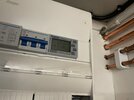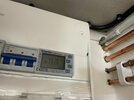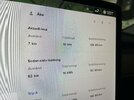I have a lot of examples better than 91%, I think I did write about this before here ( I understand of course if you didnt see my posts about this

)
Today, I had a charge about 0300 or so this night(from around 30-35% SOC).
I drove to work, the car was parked for about six hours (sentry off, around 15-20C outside) and then I drove home.
The speed was about 55-60mph mostly for the highway part and some slower driving in both ends.
When i arrived at home I did set the car to charge asap(for the sake of this thread).
I had driven 93 km witjh an average of 151Wh/km = 14.043 kWh used.
I took a picture of the for billing approved electrical meter(mounted directly before the WC) the seconds before the charge was started and another when the charging was finished.
The difference was 14.37kWh so this points at about 2.3% loss in all.
I used the Tesla Wall Charger V2 with 11 kW power (three phase 230V x 16A).
I guess that the SOC might not be precisely the same(both said 56% but maybe not the same down to the points), and I probably have the data to look this up later.
View attachment 819174
View attachment 819175
View attachment 819176
I guess that a full charge whreee you let the car sit over the night (EPA protocol if I dokt miss-remember?) will cause a full bsttery balancing, which is done by burning the over voltage cells down will cost some energy. I slso guess that a full battery will have much more self drain over the night than a 55% charge will have at short term basis.
My other measurements have pointed at 10% or more with a cold battery needing heating, or a slow low power charge with 2-3kW also about 10-12%
A regular 11kW charge where not heating pf the battery was needed have been around 5% or slightly less.
My energy meter is new, bought and mounted when the WC was installed.
The energy meter
should deliver very precise values per the specs and the approval for charging for electricity.





